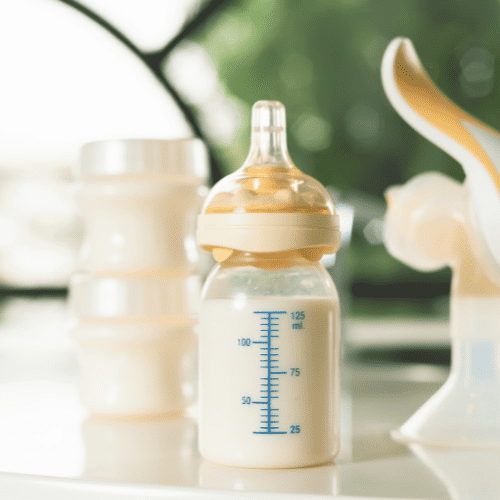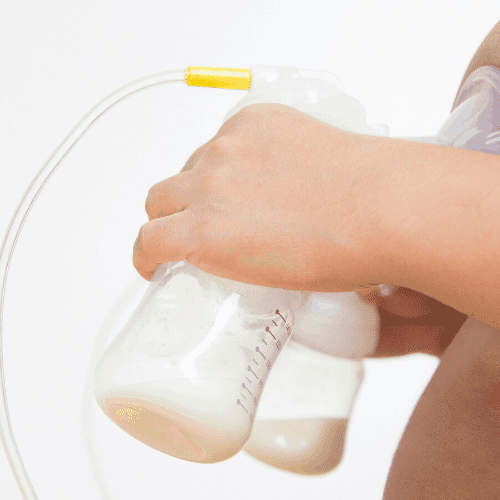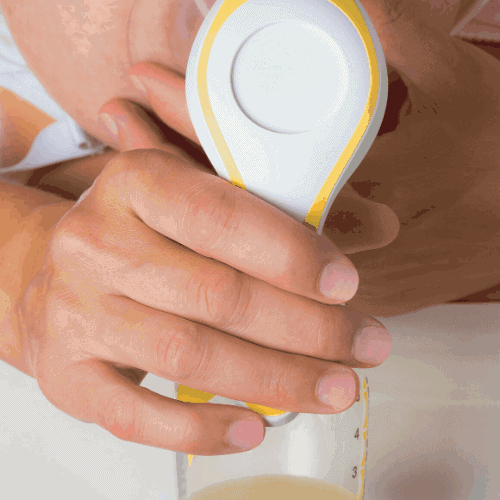Whether you have decided to stop your milk production to formula feed or you have naturally reached the end of your breastfeeding journey with your little one there is one question that immediately springs to mind – How can I dry up my milk supply?
As an Amazon Associate I earn from qualifying purchases. The links below may be affiliate links. Please read my disclosure policy for more information.
When does milk production begin?
In order to understand how quickly your milk supply could dry up, otherwise known as Lactation Suppression, you need to first understand when your milk supply started and how to maintain it.
From as early as 16 weeks pregnant your body starts producing a thick yellowy substance called colostrum. Some women find their breasts secrete colostrum from as early as 28 weeks.
This liquid gold is full of antibodies that help boost your baby’s immune system and fight off any early infections.
For the first few hours after your baby is born, she will be very awake and alert, you should make full use of this time and breastfeed her within an hour of being born.

After this initial adrenaline has worn off your baby will likely sleep for a long time, this period of sleep could last up to 24 hours.
For the first 3 days, your baby’s appetite will continuously increase as they move from being able to ingest 2-10 ml of colostrum to 15-30ml by day 3.
Around day 3 or 4 after delivery, you will notice that your breasts get firmer and this is a sign that your milk is ‘coming in’.
If you are choosing to breastfeed, you then need to maintain your supply. Here are a few simple ways you can do that,
- Breastfeed or pump often. Your breast milk is driven by supply and demand meaning that you need to be either feeding or pumping regularly to keep producing milk. It is advised that you should aim to nurse or pump around 8 times a day. If your baby isn’t feeding enough and you don’t have a breast pump to hand you can gently use your hands to massage your breasts and encourage that ‘let down’ of milk.
- Make sure your baby is latched on correctly. An incorrect latch will not only cause you pain but will most likely result in your baby not getting enough milk. This will lead to a gradual decrease in your supply.
- Feed from both breasts. Stimulation of your breasts leads to them producing more milk. So in order to get the most out of your supply you should aim to feed from both breasts. Whether you stick to one or alternate during one feed is a matter of preference but you should aim to offer a different breast with each feed.
- Make sure you are avoiding medications that decrease milk supply. Certain medicines have been known to cause a disruption to your milk supply. In particular medicines that contain pseudoephedrine, a well known example being Sudafed. You should also be cautious when taking contraceptive hormones as these can decrease your supply and should be discussed with your healthcare provider.
- Maintain a healthy diet and rest. Rather than try to find particular food types that may increase your breast milk supply you should just aim to eat a well balanced diet with a lot of fruit and veg. Avoid smoking or consuming large quantities of alcohol and ensure you are getting plenty of rest.

Is there a fast way to dry up breast milk?
Some women have the need to dry up their breast milk straight after their baby is born. You may fall into this category if; you are choosing to formula feed instead, you have medical reasons for not breastfeeding or you experienced the loss of your baby.
Whatever the reason may be, you have a couple of options you can approach. You should discuss these with your health care provider to come up with a plan that suits you.
You may be interested in trying the natural route and allowing your breast milk to dry up naturally. It can typically take between 7 – 10 days for your breast milk to dry up on its own without intervention.
It is possible that during this time your breasts will become engorged with milk and you may feel uncomfortable. In order to make this time more comfortable for you, it is recommended that you wear a sports bra and take ibuprofen to help with the inflammation.
A popular trick amongst mums is to use raw cabbage leaves as a way to ease your sore breasts. Pop these in the fridge or freezer first and then nestle them into your sports bra.
You are also advised to not stand with your breasts under warm shower water for too long, this can stimulate your breasts to produce milk.
Reducing your milk supply has a direct effect on hormone changes in your body. In particular the two hormones Prolactin and Oxytocin, when produced they encourage your body to produce milk and also help you bond with your baby during nursing.
When you stop your milk supply these hormones rapidly decrease and in some women, this can lead to late-onset postpartum depression. It is important you reach out to your doctor for advice if you begin to feel depressed or notice strong hormonal changes.

How to avoid mastitis?
Whether you have never breastfed or have breastfed for years, you should not attempt to dry up your breast milk without a plan in place. Simply stopping can lead to mastitis.
Mastitis is the inflammation of your breast tissue that could lead to an infection. It can be very uncomfortable with symptoms such as swelling, redness, and breast pain.
If left untreated you could develop breast abscesses full of pus and, in severe cases, mastitis can be fatal.
If you have been breastfeeding for a while it could take several weeks for your milk supply to diminish. So you should follow these tips to slowly start decreasing your supply.
- Reduce your nursing/ pumping sessions. Decide on the easiest nursing time of the day and offer your baby either another liquid or a fun distraction instead. It is notoriously hard to wean your baby off the night feeds and so dropping these feeds may take a little more patience and lots of cuddles.
- Use Sudafed. As previously mentioned Sudafed contains pseudoephedrine which decreases the production of breast milk by up to 24% as proven in one independent study. This method is not recommended without the supervision of your doctor.
- Discuss anti-lactation meds with your doctor. There are a small number of prescription medicines you can take that will disrupt your milk supply. However these will need to be discussed with your doctor because some of them cannot be taken whilst you are breastfeeding. So if you take them whilst gradually decreasing your supply you can risk serious harm to your baby.

Can my breast milk supply come back?
This process is called Relactation. It is the process of bringing back your breast milk supply after you have stopped it.
You may want to do this if; you were unsuccessful at breastfeeding but want to try again, you have been away from your baby for a long period of time, you have had a medical procedure and weren’t allowed to breastfeed prior to this.
It is not guaranteed that your milk supply will fully return and you may need to supplement it with formula. The results vary from person to person.
In order to produce milk your breasts will need to be stimulated, you can either stimulate them by allowing your baby to suckle or you can use a breast pump.
It may be a few days before you see any milk at all but don’t be deterred, you are still sending signals to your brain to produce the hormone Prolactin which initiates lactation.

You should aim to nurse or pump every 2-3 hours and keep this up consistently even when you start to produce milk so that your supply steadily increases.
Another way to stimulate your milk supply is through skin-to-skin contact with your baby. These important cuddles work by stimulating you to release the hormone Oxytocin which in turn sends signals to your brain to start producing milk.
It also creates a relaxed atmosphere in which you and your baby can find the right nursing position and perfect your baby’s latch.
In summary with careful planning and under the supervision of your health care provider you will be able to safely dry up your milk supply.
There may not be a quick fix, but in some respects, this is for the best due to the risks of mastitis and, even postpartum depression linked to lactation suppression. If breastfeeding is something you want to revisit then you can rest assured that once your milk supply is gone, it doesn’t have to be gone forever.
Through consistent pumping and a little patience, you can reinvigorate your milk supply and reintroduce breastfeeding to your baby.






